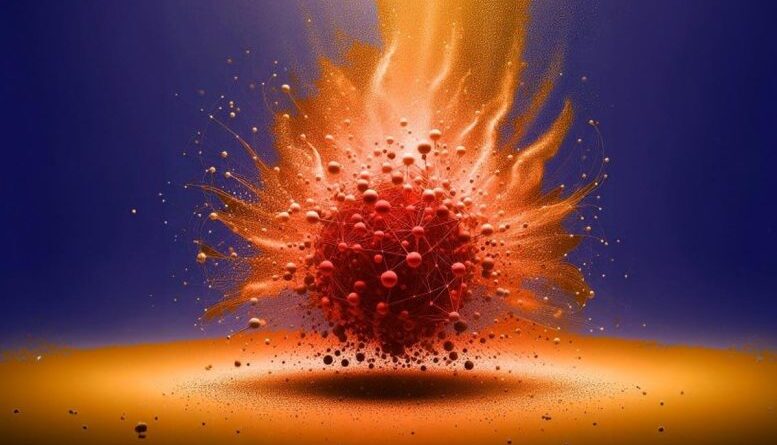The Emerging Myths of the Big Bang: Amazing Insights into the Origins of the Early Universe.
By

Artist’s impression of the particles produced by the collision of two heavy atoms. As the hot subatomic soup cools, the newly formed particles descend into space. Credit: Joseph Dominicus Lap, edited
Scientists have recreated the extreme conditions of the early universe with particle accelerators, revealing surprising details about the creation of matter.
New calculations show that up to 70% of the particles can be produced in a later reaction rather than the original quark-gluon soup that was formed immediately after Big Bang. The discovery challenges previous ideas about the timeline of creation and suggests that most of the matter around us arose much later than expected. By understanding these processes, scientists can better explain the results of collision experiments and improve their knowledge of the origins of the universe.
Recreating the Extreme Conditions of the Early Universe
The early universe was 250,000 times hotter than the core of our sun. It is too hot to make the protons and neutrons that make up everyday matter. Scientists recreate the conditions of the early universe by accelerating atoms to the speed of light. Measuring the effect of the particle shower allows scientists to understand how matter is formed.
The particles that scientists measure can form in different ways: from a primordial soup of quarks and gluons or from a secondary reaction. These recent changes began 0.000001 seconds after the Big Bang, when particles made up of quarks began to interact. The new calculation found that about 70% of the measured particles come from these recent events, not from the same events as in the early universe.
Understanding the Origins of Matter
These findings improve scientific understanding of the origin of matter. It helps to determine how many objects around us appeared in the first fraction of a second after the Big Bang, compared to how many objects appeared as a result of later actions- how the universe is expanding. This result means that many things around us are made later than expected.
To understand the results of the collider experiments, the scientists have to lower the particles created in the back reaction. Only those made of subatomic soup reveal the early conditions of the universe. This new figure shows that the number of measured particles formed in the reaction is much higher than expected.
The Importance of Later Ideas in Role Formation
In the 1990s, physicists realized that certain particles appeared in large quantities from the reaction after the first part of the universe’s formation. Particles called D mesons can interact to form an unusual particle, charmonium. Scientists did not agree on how important the effect is. Because charmonium is so rare, it is difficult to measure.
However, recent experiments provide data on how many charmonium and D meson colliders produce. Physicists from Yale University and Duke University used new data to calculate the strength of this effect. It turns out to be much more valuable than expected. More than 70% of the measured charmonium can be formed by the reaction.
Implications for Understanding the Origins of Matter
As the hot soup of subatomic particles cools, it expands into a fireball. All this happens in less than a hundredth of the time that light takes atom. Because this is so fast, scientists don’t know exactly how the fireball expands.
The new figure shows that scientists do not need to know the details of this increase. Conflicts produce large amounts of charmonium regardless. The new result brings scientists one step closer to understanding the origin of matter.
Reference: “Hadronic J/ψ regeneration in Pb+Pb collisions” by Joseph Dominicus Lap and Berndt Müller, 11 October 2023, Physics Letters B.
DOI: 10.1016/j.physletb.2023.138246
This work was supported by the Department of Energy’s Office of Science, Nuclear Physics program. One of the researchers also acknowledges the hospitality and financial support provided during the sabbatical at Yale University.
#Emerging #Myths #Big #Bang #Amazing #Insights #Origins #Early #Universe
